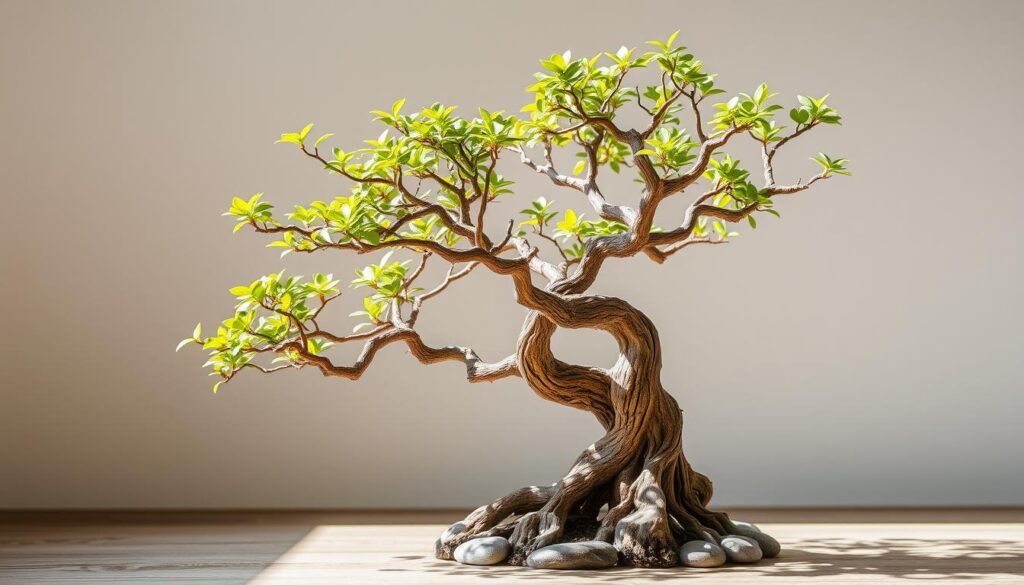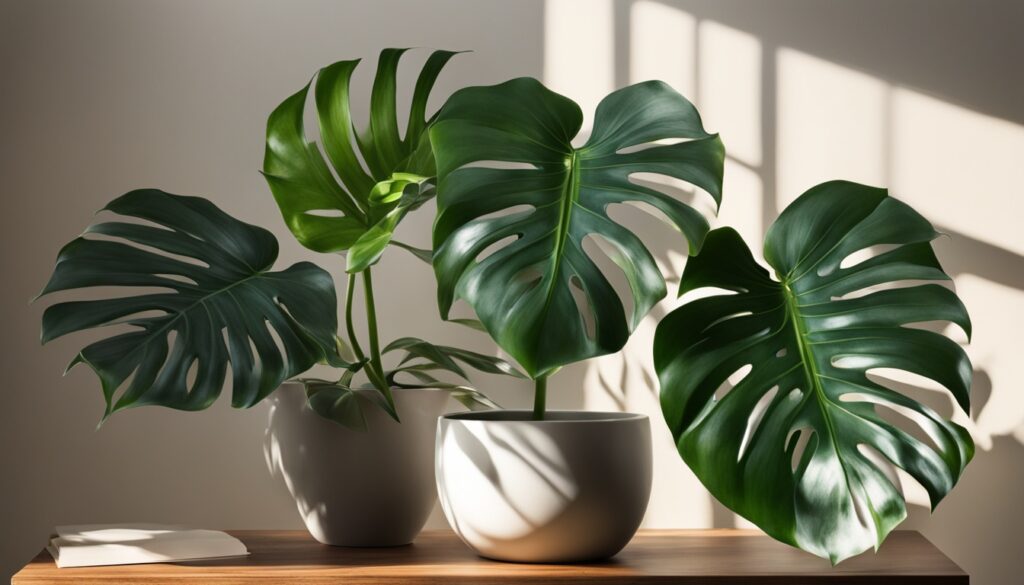Ever thought about turning weathered wood into beautiful, tiny bonsai trees? Driftwood bonsai trees are a unique way to bring nature’s beauty into your home or aquarium. But what makes these creations different from regular bonsai, and how can you make your own driftwood bonsai wonders? Discover the magic of this craft and start creating your own natural wood art.
Key Takeaways
- Driftwood bonsai trees are crafted from aquarium-safe, weathered wood, not real bonsai trees.
- Branched driftwood bonsai trees are easier to plant and offer more plant selection options.
- Most driftwood bonsai trees initially float, requiring waterlogging or anchoring methods.
- Driftwood can be purchased from local fish stores or online retailers in various sizes and shapes.
- Proper preparation and treatment of the driftwood are essential for its long-term use in aquariums and terrariums.
Understanding Driftwood Bonsai Fundamentals
The art of making seaside trees from driftwood is both captivating and complex. Choosing the right wood is key. Manzanita and other weathered branches found by coastal botanicals are perfect. They have unique shapes and textures that fit the bonsai look well.
Types of Wood Suitable for Bonsai Creation
- Manzanita
- Driftwood branches
- Juniper
- Cypress
Essential Tools and Materials
- Pruning shears
- Wire cutters
- Rooting hormones
- Aquarium-safe gravel
- Thin branches
- Moss and other decorative elements
Basic Design Principles
When making driftwood sculptures, pick wood with gnarled bark and interesting shapes. These should look aged and weathered. Pruning and shaping are crucial to get the bonsai look you want. Thinking about the final piece helps guide your work.
With the right tools and materials, you can create these seaside trees. They will have character and connect us to nature.
“The true essence of bonsai lies in the artist’s ability to capture the spirit and character of a tree, no matter how small or gnarled it may be.”
Selecting the Perfect Driftwood Piece
Choosing the right driftwood is key for creating stunning beach wood carvings or detailed knotted wood artistry for your bonsai. Look for wood that’s gnarled and weathered. It should have unique shapes and textures to add a natural touch to your bonsai.
Think about the size and shape you want your bonsai to be. You can find driftwood in nature or buy it from specialized stores. Some places even let you pick your own driftwood. Picking the right piece can make your bonsai look like a masterpiece.
| Driftwood Type | Characteristics | Aquarium Suitability |
|---|---|---|
| Malaysian Driftwood | Rich coloration, forest-like bark, realistic tropical setting | Requires thorough cleaning, waterlogging, and sterilization |
| Manzanita Driftwood | Durable, resistant to decay, sinks easily in aquarium | Doesn’t leach tannins, making it a popular choice |
| Dragon Driftwood | Available in various sizes, unique root-like configurations | Needs extensive preparation for aquarium use |
By picking the perfect driftwood piece, you open up new possibilities for your bonsai. It can become a beautiful piece of art that highlights the beauty of wood.
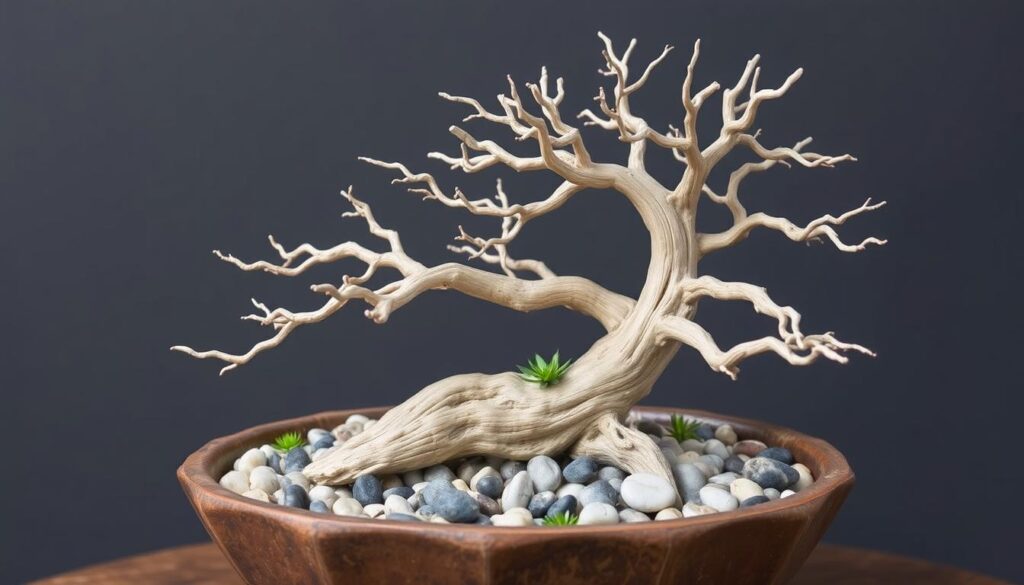
Natural vs Artificial Driftwood for Aquascaping
Choosing between natural and artificial driftwood can greatly affect your aquascape’s look and the environment. Natural oceanic plant cultivation might need more work but brings unique shapes and textures. Artificial shoreline timber formations are pre-treated and can be used right away.
Benefits of Each Type
Natural driftwood can be a stunning centerpiece with its detailed patterns and shapes. But, preparing it involves soaking, boiling, and testing for tannins, taking more time. Artificial driftwood is ready to go, saving you prep time.
Environmental Considerations
Choosing natural driftwood means thinking about its environmental impact. Getting it from oceanic plant cultivation or shoreline timber formations helps protect these areas. Artificial driftwood is easier but lacks the ecological benefits of natural wood.
| Feature | Natural Driftwood | Artificial Driftwood |
|---|---|---|
| Unique Shapes and Textures | ✔️ | ❌ |
| Preparation Time | Higher | Lower |
| Environmental Impact | Dependent on Sourcing | Lower |
| Suitability for Fish Species | Varies | More Consistent |
Deciding between natural and artificial driftwood depends on your preferences, your fish’s needs, and your eco-friendly goals. By considering these factors, you can build a beautiful and eco-friendly aquascape that will last for years.
Preparing Your Driftwood for Bonsai Creation
To make beautiful driftwood bonsai trees, you need to prepare the wood well. This is true whether you use real or fake driftwood. The early steps are key to a great bonsai project.
Start by washing natural driftwood to remove any dirt or chemicals. This makes a clean start for growing your bonsai. Even if you’re using fake driftwood, a good clean is always a good idea.
For real driftwood, boiling it can make it waterlogged faster. This means soaking the wood in water for a long time. It makes sure the wood is ready for the bonsai process. Tannins, which can be a problem with real driftwood, are not a big deal with fake pieces.
| Driftwood Type | Preparation Steps |
|---|---|
| Natural Driftwood |
|
| Artificial Driftwood |
|
By carefully preparing your driftwood bonsai materials, you’re ready for a successful project. With a solid base, you can start creating your own bonsai art.
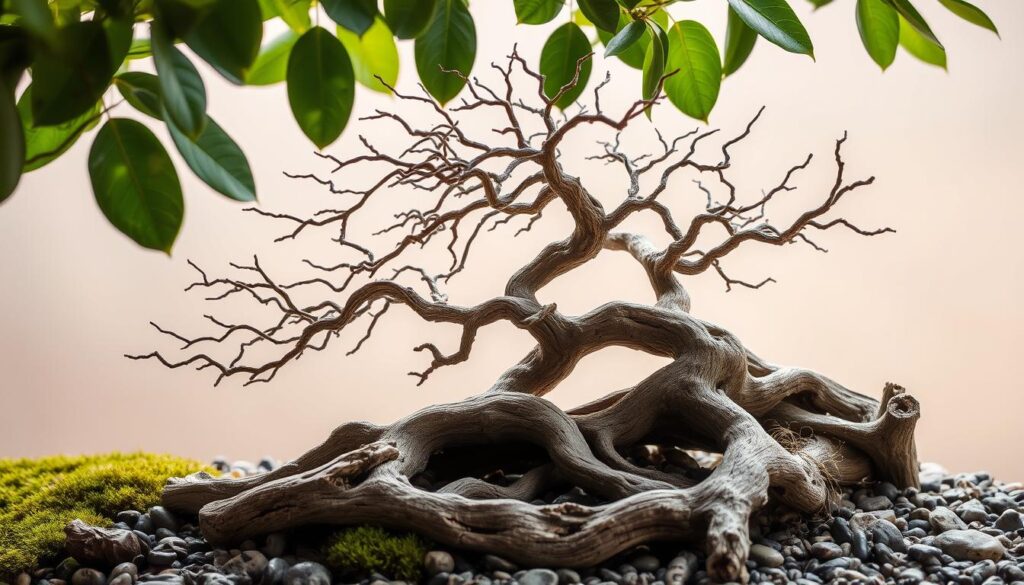
Essential Tools and Materials for Crafting
Turning driftwood into beautiful bonsai trees needs the right tools and materials. The right tools help shape and refine these natural wood art pieces. Whether you’re new or experienced, knowing the essential tools and materials is key for creating driftwood bonsai.
Required Equipment List
- Pruning shears: Sharp, high-quality pruners are essential for precise trimming and shaping of the driftwood and any attached foliage.
- Wire cutters: Sturdy wire cutters are necessary for cutting and manipulating the binding wires used to secure the driftwood to the bonsai pot or base.
- Rooting hormones: These specialized hormones encourage the growth of healthy roots, aiding the establishment of your driftwood bonsai.
- Bonsai soil mix: A well-draining, nutrient-rich bonsai soil mix is crucial for providing the optimal growing medium for your driftwood bonsai.
Optional Enhancement Tools
There are also optional tools that can enhance your driftwood bonsai creations:
- Rocks: Strategically placing rocks around the driftwood can add visual interest and help anchor the tree in place.
- Gel Type Gorilla Glue: This specialized adhesive can be used to securely fix the driftwood to rocks or other natural elements, providing a stable foundation.
- Small seed starter greenhouse: For those who want to grow their own plants to incorporate into the driftwood bonsai, a small seed starter greenhouse can be a valuable tool.
With the right tools and materials, you can create stunning natural wood art pieces. These pieces showcase the beauty of driftwood and coastal botanicals. Start your bonsai journey and let your creativity grow.
Design Techniques for Driftwood Bonsai
Making driftwood sculptures and knotted wood artistry for bonsai needs a mix of vision, technique, and patience. The secret to making stunning driftwood bonsai is knowing the wood’s natural flow and unique features. By shaping, pruning, and highlighting the wood’s character, you can make your bonsai truly stand out.
The Tanuki Bonsai is a favorite in bonsai circles. It combines a living tree with weathered driftwood, looking like a natural, aged trunk. This mix of life and death shows nature’s amazing adaptability. Proper preparation and anchoring methods are key for a strong and beautiful result.
Before using driftwood in your bonsai, clean and treat it carefully. Soak the driftwood in fresh water for weeks, scrub it, and dry it in the sun. This removes salt and impurities that could harm the plant. Also, treat the bottom of the driftwood with lime sulfur to stop decay.
“The true essence of bonsai lies in the artist’s ability to capture the raw beauty and character of the wood, allowing the natural form to guide the design.”
Experienced bonsai artists use the driftwood’s natural features to hold the tree in place. This method keeps the wood’s organic flow and integrity. It makes the bonsai look more real and beautiful.
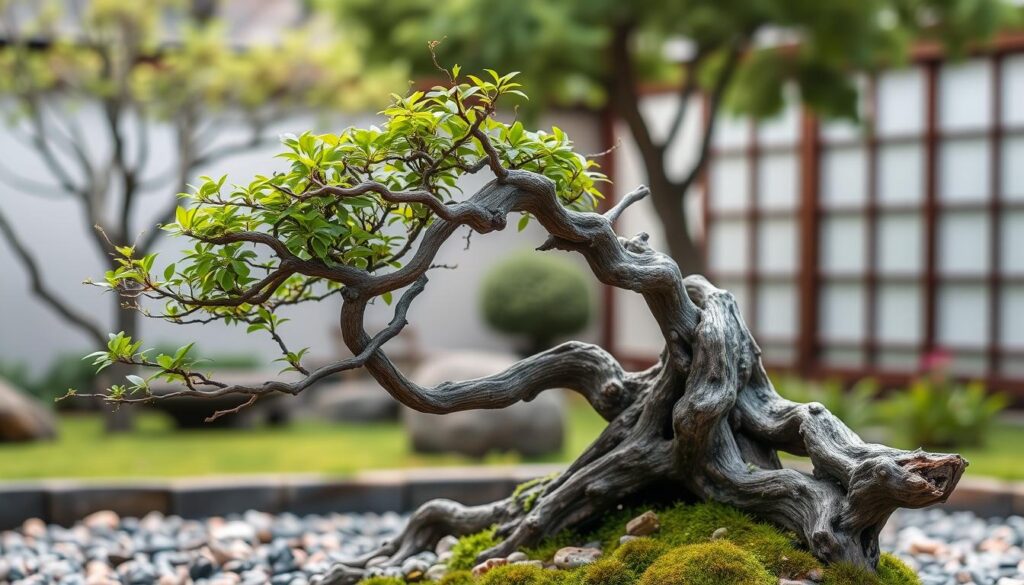
Starting your driftwood bonsai journey means embracing each wood’s unique character. With a keen eye, steady hand, and respect for nature, you can turn ordinary driftwood into amazing bonsai sculptures. These sculptures will amaze and inspire everyone who sees them.
Creating the Base Structure
Building a strong base is key when making driftwood bonsai trees. The right anchoring and stabilization are crucial. They help keep these unique trees looking great for a long time.
Anchoring Methods
Using rocks is a common way to anchor driftwood bonsai. Rocks placed around the base keep the tree stable and look natural. You can also use Gel Type Gorilla Glue to stick the driftwood to rocks for a strong hold.
Letting the driftwood sink into the substrate is another method. It’s perfect for beach wood carvings meant for aquariums. Over time, the wood becomes part of the underwater world.
Stabilization Techniques
To keep the driftwood bonsai stable, bury the base in aquarium-safe gravel. This extra support keeps the structure steady. A bit of glue at the base helps while the gravel settles.
Choosing the right anchoring and stabilization techniques is important. It helps create beautiful driftwood bonsai trees. These trees can impress anyone, whether they’re indoors or in an aquarium.
Adding Plants and Moss to Your Creation
Creating a driftwood bonsai tree for your aquarium needs lush, vibrant foliage. This is key to getting a natural look. From oceanic plant cultivation of Monte Carlo to seaside trees of various moss species, the right plants can make your underwater sculpture stand out.
Monte Carlo’s delicate, trailing growth creates a stunning weeping effect. It looks like real bonsai foliage. You’ll need 5-8 pots of Monte Carlo to cover a small bonsai tree’s canopy. Start the plants in a seed starter greenhouse before attaching them to the driftwood.
- Christmas moss
- Java moss
- Moss balls
- Anubias nana petite
- Bucephalandra
These mosses and plants complement the driftwood well. Each species has a unique texture and growth pattern. Anubias nana petite and Bucephalandra are great for the bonsai tree’s base because they’re hardy yet attractive.
| Plant | Characteristics | Care Requirements |
|---|---|---|
| Monte Carlo | Delicate, trailing growth, creates a weeping effect | May require pressurized CO2 for optimal growth |
| Christmas Moss | Dense, vibrant green growth, low maintenance | Thrives in a range of aquarium conditions |
| Anubias nana petite | Compact, hardy foliage, low light tolerance | Easy to care for, minimal maintenance required |
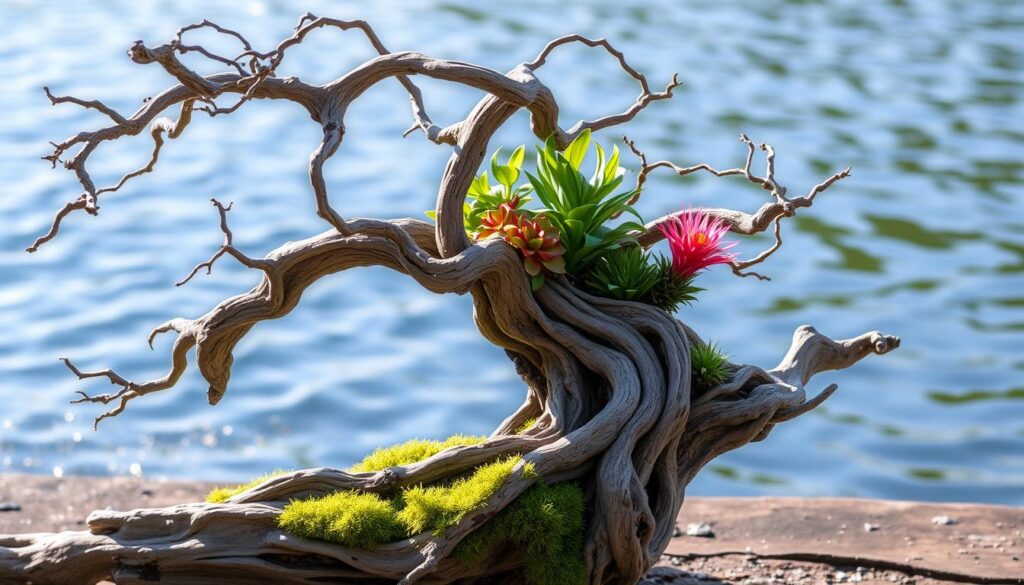
By choosing and arranging these oceanic plant cultivation and seaside trees carefully, you can turn your driftwood bonsai into a stunning, true-to-nature piece. It will surely catch the eye of your aquarium visitors.
Waterlogging Techniques for Aquarium Use
To get driftwood bonsai trees ready for aquariums, you need to waterlog them. This can take 1-3 weeks, depending on the driftwood’s size. Start by placing the trees in a bucket of water and weigh them down with a rock.
When you can lift the rock without the tree floating, it’s ready. This method ensures the driftwood is fully saturated for aquarium use.
Proper Methods
Another way is to use Gel Type Gorilla Glue. Apply it to the bottom of the driftwood bonsai trees and attach them to nearby rocks. This keeps the trees in place and stops them from floating.
The weathered wood of the driftwood bonsai adds beauty to your aquarium. It creates a stunning underwater scene.
| Waterlogging Duration | Driftwood Preparation | Benefits |
|---|---|---|
| 1-3 weeks | Submerge in water with a rock | Achieves proper saturation for aquarium use |
| N/A | Secure with Gel Type Gorilla Glue | Prevents floating, enhances aquascape design |
Using these waterlogging methods, you can add driftwood bonsai trees to your aquarium. They create a beautiful, natural underwater scene. This showcases the beauty of weathered wood horticulture.
“Incorporating driftwood bonsai into an aquarium is a unique way to bring the tranquility of nature into the home, fostering a serene and captivating underwater environment.”
Maintenance and Care Guidelines
Keeping your handcrafted driftwood bonsai trees looking great needs a lot of care. You’ll need to prune, repot, and fertilize them regularly. Each bonsai type has its own needs, so it’s important to know what yours requires.
Watering is key to keeping your driftwood bonsai healthy. Check the soil moisture often to avoid too much water. This can cause root rot. If your bonsai is in an aquarium, make sure the water is clean and safe for any fish.
| Maintenance Task | Frequency |
|---|---|
| Pruning | Every 4-6 weeks |
| Repotting | Every 2-3 years |
| Fertilizing | Every 4-6 weeks |
| Water Monitoring | Daily (or as needed) |
By following these care tips and adjusting for your natural wood art and coastal botanicals, your driftwood bonsai trees will flourish. They’ll show off their beauty for many years.
“The true beauty of a bonsai tree lies in its resilience and the careful attention it receives from its caretaker.”
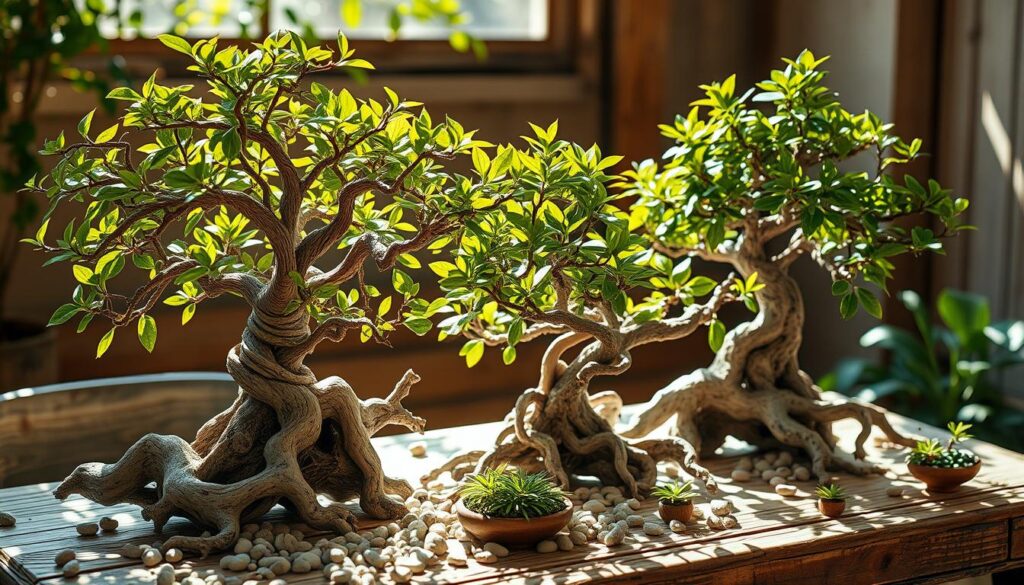
Aquarium-Specific Considerations
Driftwood bonsai trees for aquariums need extra care. Make sure the wood is fully waterlogged and manage any tannins in the water. Pick plants that fit well with your underwater bonsai setup.
- Soak driftwood until it fully sinks on its own
- Boil wood to accelerate tannin release and sanitize
- Monitor water pH and tannin levels
- Choose low-maintenance aquatic plants like Anubias and Bucephalandra
- Use aquarium-safe glue to secure plants and moss to the driftwood
Advanced Sculpting Techniques
Making stunning driftwood sculptures and knotted wood artistry needs skill in advanced sculpting. As you grow in bonsai, learning these techniques can take your art to new levels.
Branch Shaping
Exceptional bonsai have detailed branch structures. By shaping and placing each branch, you can create natural movement and balance. Use tools like wire, carving tools, and bonsai shears to shape the branches as you want.
Artistic Elements
Adding unique artistic elements can turn your driftwood sculptures into masterpieces. Try carving textures, knots, or small rock formations into the wood. These details can make your bonsai look old, full of character, and magical.
When using advanced techniques, remember to keep your bonsai balanced and beautiful. Aim to make a piece that’s both calming and connects you to nature.
“The true essence of bonsai lies in the artist’s ability to capture the beauty and resilience of nature in a small, living canvas.”
Improving in bonsai cultivation and sculpting takes time and patience. Enjoy the process, and let your creativity shine as you turn simple driftwood into amazing knotted wood artistry.
Incorporating Natural Elements
Make your driftwood bonsai stand out by adding small pebbles, miniature rocks, or other seaside trees and wood carvings. These elements can make your underwater scene look more real and beautiful. Think about the natural home of the plants you choose to make your aquascape feel authentic.
When keeping deadwood bonsai trees, think about the wood’s type, age, color, and how decayed it is. Trees like deciduous ones are more prone to decay and need constant care. But, trees like taxus, junipers, and pines are strong and live long, making them great for driftwood bonsai.
Use dark lava rocks to contrast with lighter bonsai wood for a natural look. Plants like Anubias nana and Java fern work well because they’re small and tough. You can attach plants to the wood with thin fishing line, cotton thread, fine wire, or glue, depending on the plant size.
| Natural Element | Benefits |
|---|---|
| Small Pebbles | Add texture and depth to the aquascape |
| Miniature Rock Formations | Create a more realistic and visually interesting landscape |
| Additional Seaside Trees or Beach Wood Carvings | Enhance the overall theme and cohesive design of the bonsai |
Adding sea shells, weathered pebbles, or dried seaweed to driftwood bonsai can make it more appealing. Driftwood as a bonsai base connects us to the ocean and nature. It brings a sense of wonder and nostalgia to both artists and viewers.
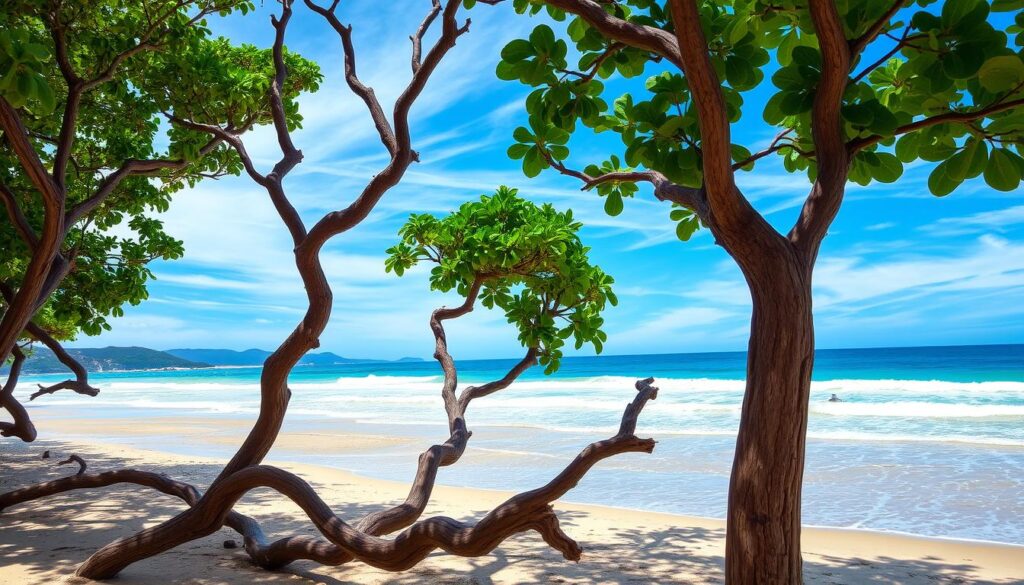
Creating a stunning driftwood bonsai is all about balance. Artists use design principles like proportions and contrast to make their work beautiful. They aim to tell a story through their art, combining the beauty of weathered wood with the elegance of a miniature tree.
Troubleshooting Common Issues
Creating a thriving driftwood bonsai comes with its own set of challenges. But, with the right troubleshooting, you can overcome these obstacles. Let’s look at solutions for issues like floating driftwood, algae growth, and plant die-off. This will help keep your weathered wood horticulture project healthy and vibrant.
Addressing Floating Driftwood
If your driftwood won’t stay underwater, there are ways to keep it in place. Start by soaking the wood for a long time to fully saturate it. You can also use wire, weights, or silicone sealants to anchor it to the substrate.
Controlling Algae Growth
Too much algae can ruin the look of your driftwood bonsai. To fight this, adjust the lighting to the right amount for your driftwood. Also, keep an eye on the water’s nutrient levels to prevent algae from growing too much.
Preventing Plant Die-Off
If your plants are struggling or dying, check the water’s conditions. Make sure the pH, temperature, and oxygen levels are right for your plants. Adjust these as needed to help your plants thrive.
By tackling these common issues, you can keep your driftwood bonsai thriving. Enjoy the beauty of this unique and captivating art form.
Display and Positioning Tips
Creating a stunning driftwood bonsai requires careful thought on display and positioning. Start by thinking about the lighting your plants need. Place the driftwood in a bright spot to help plants grow well and show off the wood’s beauty.
Try out different spots to find the best look for your aquascape. Make sure the driftwood fits well with the natural wood art and oceanic plant cultivation around it. Play with angles and depth to make a focal point that catches the eye.
Lighting Considerations
Good lighting is crucial for your driftwood bonsai’s health and look. Check what light your plants need and place them right. The right mix of light and shadow can make the wood grain pop and create a stunning scene.
Aesthetic Placement
- Make the driftwood bonsai a main attraction, drawing all eyes to it.
- Put it in a spot that adds depth and interest to your aquascape.
- Try different angles and views to find the most eye-catching one.
- Use oceanic plant cultivation to add to the natural beauty of the driftwood bonsai.
By thinking about lighting and where to place your driftwood bonsai, you can make your underwater art stand out. It will draw people in and take them to a peaceful underwater world.
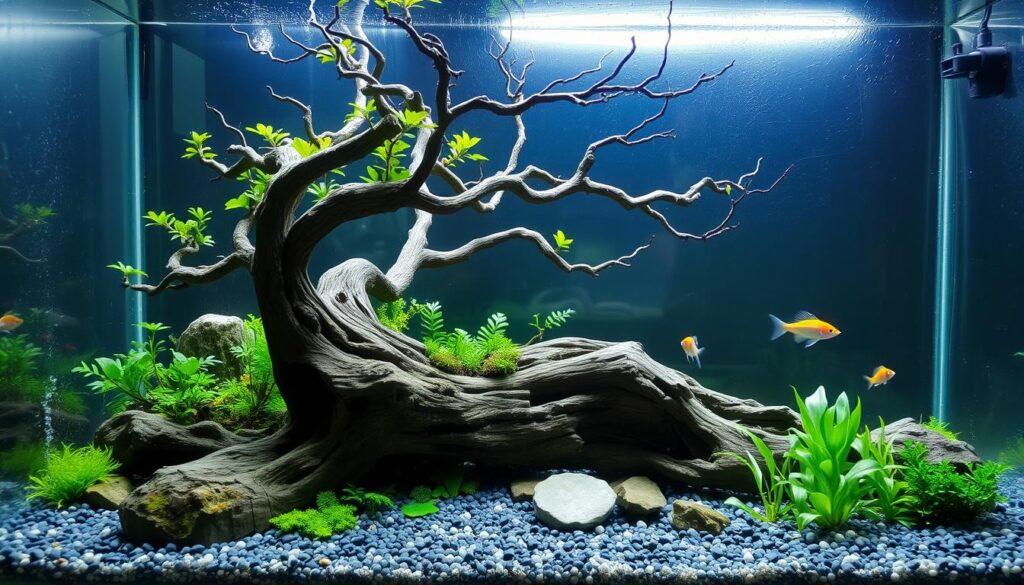
Conclusion
Creating a driftwood bonsai tree for your aquarium is a fun and unique hobby. It mixes the art of aquascaping with growing bonsai. With the right care and dedication, you can turn ordinary driftwood into beautiful underwater gardens.
These gardens can become the highlight of your home. Make sure to think about what plants and fish you have. This way, you can create a peaceful and healthy space for them.
Driftwood bonsai in Betta aquariums is becoming more popular. These creations make your tank look better and help your Betta fish. They provide places for your Betta to hide and rest, making their home more welcoming.
Driftwood bonsai is for everyone, whether you’re new or experienced. It’s a chance to be creative, relax, and connect with nature. Keep exploring and enjoy making your own special underwater art.
